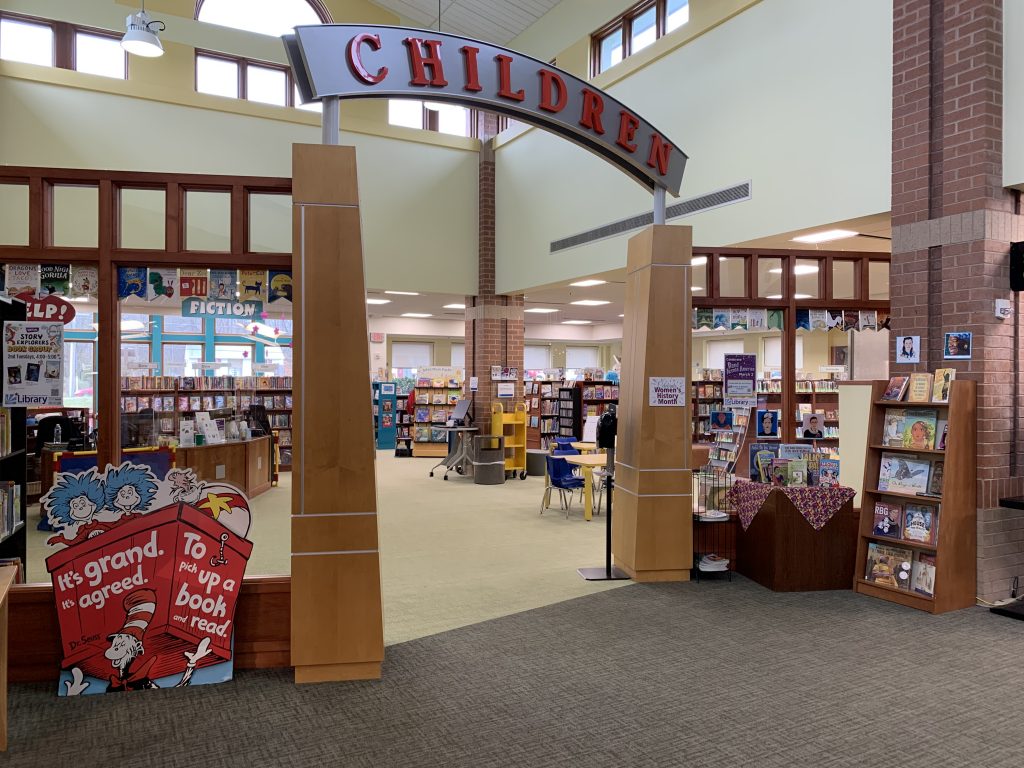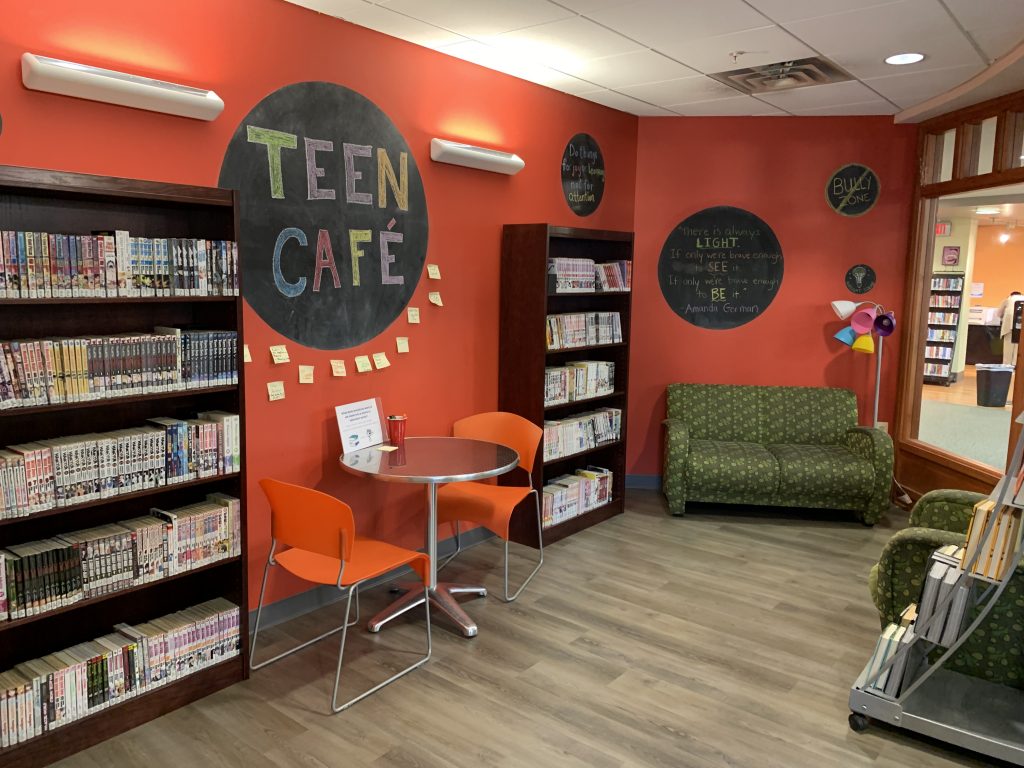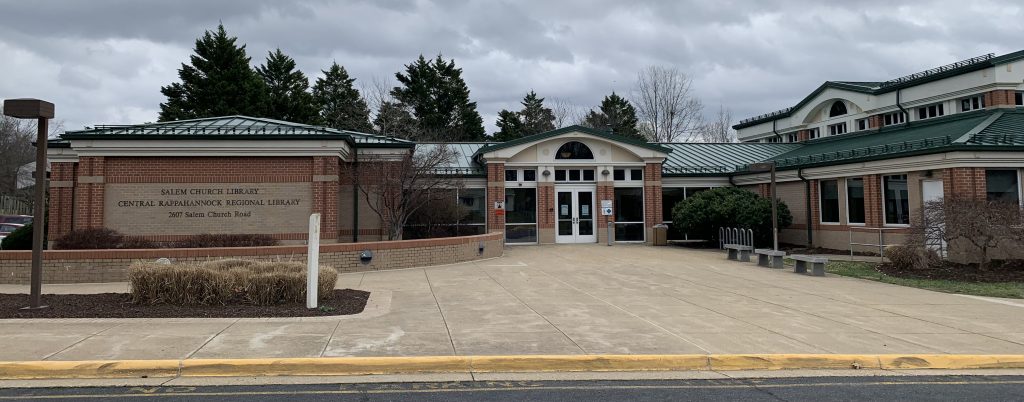For my public library visit I chose to go to my local branch of the Central Rappahannock Regional Library System, the Salem Church Library. This is a library that my family uses often. I was excited to visit today with more of a critical eye.
Digital Access
The library’s website can be found at https://www.librarypoint.org/. I am a frequent user of the website and I find it to be very comprehensive and easy to navigate. Users can search the catalog as a public user, and can place holds if they log in with their library barcode number and password. The website offers a wealth of information regarding services that are offered, collections of books that are being promoted, as well as special events.
The Central Rappahannock Regional Library System is very active on social media including Facebook, Twitter, and Instagram. They use it to promote events and programs and to engage with the community. I am a part of one of their Facebook groups called “CRRL Book Chat,” where users respond to questions about books, authors, or other topics and participate in book giveaways and challenges.
Other digital features include the app Libby for e-book and audiobook access, an app called Kanopy Kids for online streaming of educational content, and the CRRL Mobile App that can be used to browse collections, place holds, and check out items. They also provide an “Ask a Librarian” feature, where users can get personalized book recommendations or answers to any other questions patrons may have.
Space/Physical Access
This library is located on a side street about a mile down from one of the main roads in our town. It is surrounded by neighborhoods and some businesses. The library is easy to find, thanks to multiple signs directing people to the location on various side and main roads. Sidewalks lead to and from the front entrance, and the outside of the building looks attractive and well-maintained. There is an area for a drive-through book drop and curbside pickup. The location also offers outdoor benches, ramps for wheelchairs, a bike rack, and has a bus stop close by.
The library is all one level with an open floor plan. There is a good amount of space to navigate in and around various sections and around bookshelves, which would be helpful for patrons who are in wheelchairs or walkers. It is clean and bright with a lot of natural light from large windows throughout. There is also art from local artists and elementary schools on display. Compared to other branches of this library system, this location is smaller and feels cozier inside to me, which I prefer.
When you first enter the space, there are two large meeting rooms to the left and the main library area to the right. The main area provides designated sections for children, teens, and adults. There are also quiet study rooms, small meeting rooms, a variety of tables and desks, couches and chairs for leisure reading, and computer workstations. This location even provides a public kitchen, which I found surprising but is a nice feature. There are also desks that are staffed with library staff throughout the space.
I paid special attention to the children and teen areas. Both were warm and inviting spaces, well organized and clearly labeled by genre, series, or topic, and incorporated activities to engage these age groups. For example, kids can participate in a library scavenger hunt, coloring pages and word searches. Teens can write book recommendations on sticky notes to post on the wall, print out and hang (appropriate) library memes, and browse books that have been trending on #BookTok (books that are being talked about on TikTok).


Services/Intellectual Access
The CRRL’s mission is to “inspire lifelong learning for everyone in our community” (Central Rappahannock Regional Library, n.d.), and I can see that they truly make an effort to do this in the services that they offer. I was very impressed with the wide variety of programming that the library provides. All of their programs are well advertised with colorful signs in the library, in their monthly magazine, and on their website. Offerings include book clubs for teens and adults, a “Memory Cafe” where adults with early memory loss can relax and reminisce together, reading with therapy dogs, teen poetry and writing groups, story time and “Grow a Reader” children’s classes, “Lunch and Learn” Fridays on various topics, knitting and craft groups, conversation groups where English language learners can practice with each other, comic groups, employment workshops, chair yoga, and many more. They advertised upcoming events like a teen art show and a visit from author Dr. Ibram X. Kendi, who wrote the book “How to Be an Antiracist” and is giving a talk on race in the workplace. Many of these programs are still virtual due to COVID but I was told they will be returning to in-person very soon.
The “Library on the Go” program provides both resources and programming for people who may not be able to physically come to the library. They have a youth services outreach van which goes to neighborhoods in need, “Grow a Reader” which visits preschools and childcare facilities, and “Lobby Stops” for assisted living facilities and senior apartments. They also offer satellite locations in rural areas that do not have their own library building. In these locations, patrons can use printers and computers, access wifi, get homework help, and pick up book and movie holds.
One service that I appreciate as a teacher is “Classroom Carryout” – a partnership with local schools where teachers can put in a request for a librarian to gather materials on a certain topic tied to instructional needs. The teacher can then pick them up and borrow them for at least two weeks.
Additional services include notarizations, tax services, tutoring (in both English and Spanish), and DMV connect- a portable office that comes to the library to process driver’s licenses, ID cards, titles and registrations. The library has also provided free Covid tests to the community when they are in stock.
People- Patrons & Staff
The library is located in the middle of a diverse community and alongside neighborhoods of various socio-economic status, including low-income housing. It serves everyone from the very young to the elderly and various races and ethnicities. While I was there, I saw about an equal number of white and black patrons, as well as a few asian and hispanic people. I observed several patrons speaking in different languages, mostly Spanish. I also found out from speaking to a librarian that they have many homeless users as well as “latchkey” kids who come in after school. She told me she feels they are drawn here because it is welcoming, warm, and safe (B. Murray, personal communication, March 19, 2022).
I only saw women staffing the library on this day; however, I know from my previous visits that there are at least two males that work here as well. I did see a variety of races and ethnicities, including white, black, hispanic, and Indian. Each library also has at least one security officer.
I saw patrons engaging with library staff in the following ways: requesting and unlocking study rooms, asking for assistance with technology like computers, copiers, and how to edit a PDF document, scheduling appointments for tax services, asking where certain materials were located, and checking books in and out. I also saw library staff explaining to patrons about their website and apps like Libby, that they can use for audio and e-books. I spoke with two library assistants at length who move from location to location as needed, working mostly as substitutes. They were both retired teachers and expressed that they really enjoyed working at this library.
Collections
This library offers standard fiction and nonfiction collections as well as themed displays that make an effort to promote diversity and inclusion. The children, teen, and adult sections all had “Women’s History Month” areas featuring a variety of materials on strong women with a wide range of races and ethnicities. There was a special display borrowed from the Library of Virginia called “True Sons of Freedom” that highlighted photographs and stories of black soldiers who fought during World War 1. The tagline was, “They served the nation that refused to serve them,” and it was a very powerful display. I also noticed that in the teen section, many of the books facing outward on display featured characters of color and some were LGBTQ+ themed books, although there was nothing explicitly stating it.
A new collection that a librarian was excited to tell me about is their “Library of Things,” where patrons can borrow outdoor game kits, environmental devices like radon detectors and energy usage monitors, hotspots, chromebooks, ring lights, DJ kits, and other “tech-on-the-go” items. In addition, there were some features in the children’s area that I appreciated as a busy parent, like grab and go themed book bags and adventure packs- books on a variety of topics packed in a backpack that you can borrow.
The library has made attempts at increasing accessibility for disabled users. They offer a “Deaf Culture Digital Library” collection for the hearing impaired. For students with vision, physical, or print/reading disabilities such as dyslexia, they provide Talking Books and BARD (Braille and Audio Recording Download) services. They also offer a large amount of large print books and audiobooks.
Spanish books were available in both the children and adult sections, however they were smaller than I expected them to be considering how many Spanish speaking people we have in our community. They were also in an area that was difficult to find. The computer kiosks for the catalog did ask users to choose their language before browsing; however, all other signs around the library were only in English which may make it difficult to navigate for those who do not speak English as a first language. It would also be helpful if there were Spanish translations of their monthly newsletter, program flyers and website to ensure equity in access. As we know, “the public library can and does play a critical role in supporting minority communities and serving as a hub for those who might have fewer channels to get needed information” (Rubin & Rubin, 2020, p. 112), so this should be an important priority.
Available technology included computers, printers, scanners, a fax machine, a shredder, hotspots and laptops, Launchpod activity tablets and portable read-along books for kids, charging stations, self check-out stations, and many computer-catalog locations throughout the library.
Conclusion
I have always enjoyed visiting my local library branch, but I never realized just how much the Central Rappahannock Regional Library System has to offer until I did this deep dive into it. As the ALA (n.d.) states, “Libraries are great democratic institutions that serve people of every age, income level, location, ethnicity or physical ability, and provide the full range of information resources needed to live, learn, govern, and work. Because libraries bring free access to all, they also bring opportunity to all.” Although they have areas where they can make improvements, overall I feel that they provide comprehensive and inclusive services to my community and make positive efforts toward making the library and its resources more equitable and diverse.
References
American Library Association. (n.d.). About America’s libraries. I Love Libraries. http://www.ilovelibraries.org/what-libraries-do/about-americas-libraries
Central Rappahannock Regional Library. (n.d.). Strategic plan. https://www.librarypoint.org/strategic-plan/
Rubin, R. E. and Rubin, R. G. (2020). Foundations of library and information science (5th ed.). ALA Neal-Schuman.

Katie,
Your local public library branch looks very welcoming and lovely! I enjoyed hearing about the many programs offered, the defined spaces arranged by user categories, and the special services designed to help in unique ways. I loved the look of the Teen Café, and would be interested to hear more about how it is used and enjoyed by the patrons. The space seems very cozy, is there a service desk in there or are teens unsupervised? Do you know if it serves as a gathering place or simply a quiet space to hang out and select books? I love the idea of “book Toks” and plan on suggesting that to the Teen Services Coordinator in my system! I also was interested in hearing about the “library on the go” kits for teachers. I often have teachers come in asking for books on specific topics or themes, and I think having kits prepared would be greatly appreciated. We had a similar thing called “quick pick” bags during our Covid closure, which were hand selected by theme and ready to go out by curbside service. We are about to implement a Library of Things collection in my system, and I’m really excited about it! I think this is the future direction of libraries, as we try to keep up with the changing needs of the public. According to our textbook, “the library remains a vital source for information and knowledge, but how that knowledge and information are packaged and delivered has changed dramatically” (Rubin & Rubin, 2020, p. 94). I think a Library of Things collection highlights this idea perfectly. I can’t wait to see how well ours circulates!
Rubin, R. E. and Rubin, R. G. (2020). Foundations of library and information science (5th ed.). ALA Neal-Schuman.
Hi Hannah,
Thank you for reading my very long post! I also loved the teen area and found it to be welcoming and cozy. I showed photos of it and the rest of the YA area to my teenage stepdaughter and she agreed that it is one of the more engaging libraries that she’s seen for her age group. Unfortunately I wasn’t able to see anybody using the Teen Cafe on the day that I visited, but I know from some of the posters that they host their teen art, writing, and book groups in that area and another one that wasn’t shown in my photo. There is a YA librarian service desk as well but it was unsupervised while I was there. Another librarian told me that many of their staff was out due to spring break. However, I can tell that she takes great efforts to engage teens from how she incorporates popular culture, social media, memes, TikTok, etc. into her space. I was definitely taking a lot of notes because as an elementary school teacher I am more used to the younger age group.
I am also very excited to see how the “Library of Things” concept evolves over time. I think it’s a great way to keep libraries relevant and connected to the needs of the community, and for the community to learn that there are so many learning opportunities out there, beyond traditional books.
Hey Katie,
Great post! You’re library has so many outstanding programs. I love the “Library Things” and the “Grab and Go” themed book packs. I will definitely steal the #BookTok idea in some form as it seems such an engaging and fun way to prompt reading. My personal favorite here is the partnership with the local schools. We have an incredibly well stocked library at my school but so many schools aren’t as lucky. This is such a great way to bring in resources that they might otherwise lack and a way to highlight the collections of the public library. It reminded me of a program that many museums participate in where they have trunks of curated artifacts (which often include books) that they will send to classroom teachers to use with particular units of study. The one that comes to mind that our lower school uses every year is from the Buffalo Bill Center of the West (https://centerofthewest.org/school-programs/). They will send trunks full of items on themes such as The Plains Indians, Powwow, Gray Wolf, and Mountain Men of the West for the students to explore. All of the trunks are correlated to state standards (however, I believe it is only Wyoming and Montana standards but that is easily translated to Core Standards). Many other museums do similar programs and in conjunction with themed book packets it would be amazing.
Margee
Margee,
I know, my post was so long because I was so excited about all of the different programs and offerings! Even though this is my local library I had no idea about most of it. The partnership with schools is one thing I am super excited about, especially since I’m transitioning out of teaching and into library work. I can’t wait to be able to support the schools and teachers in a different way. I love the themed trunks too – what a great idea! Thank you for sharing!